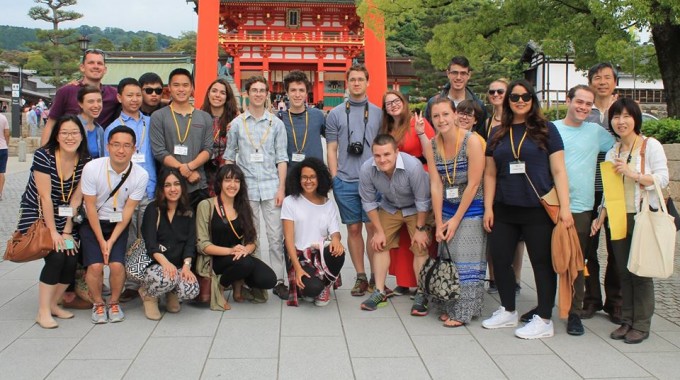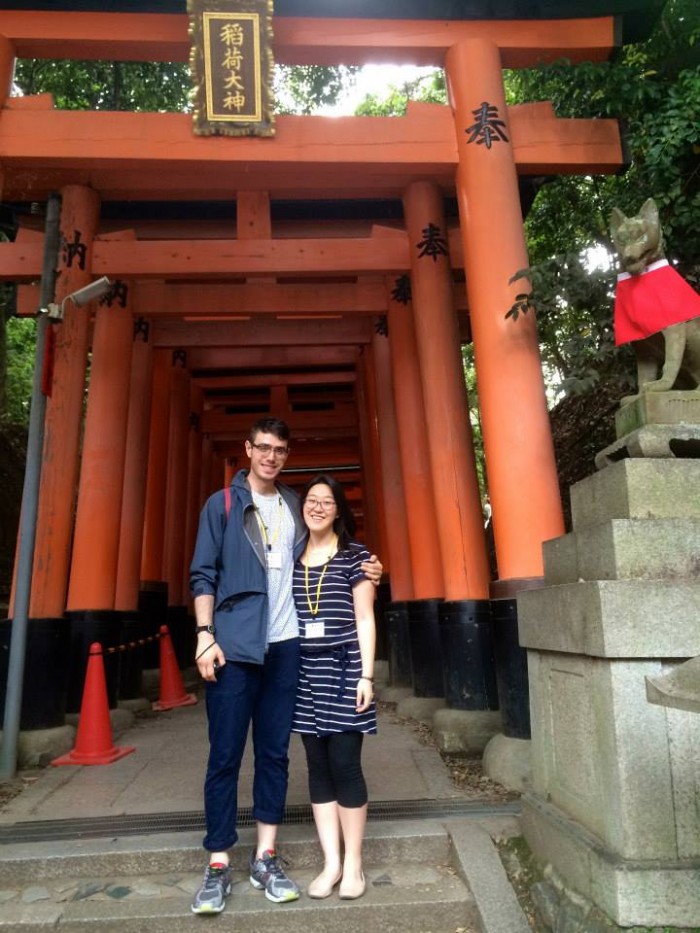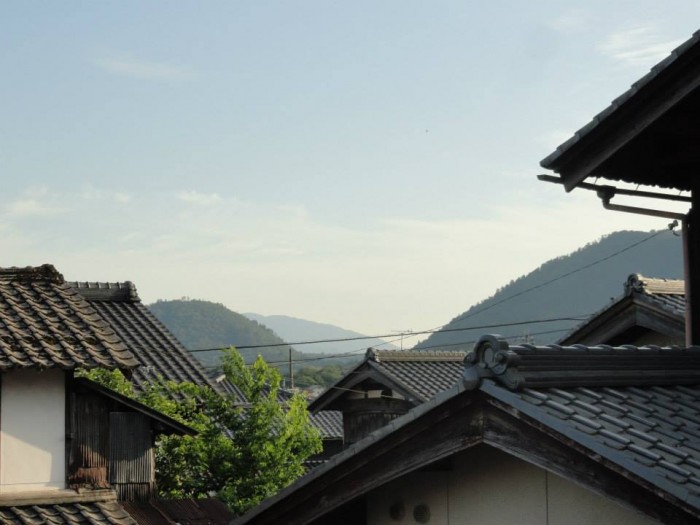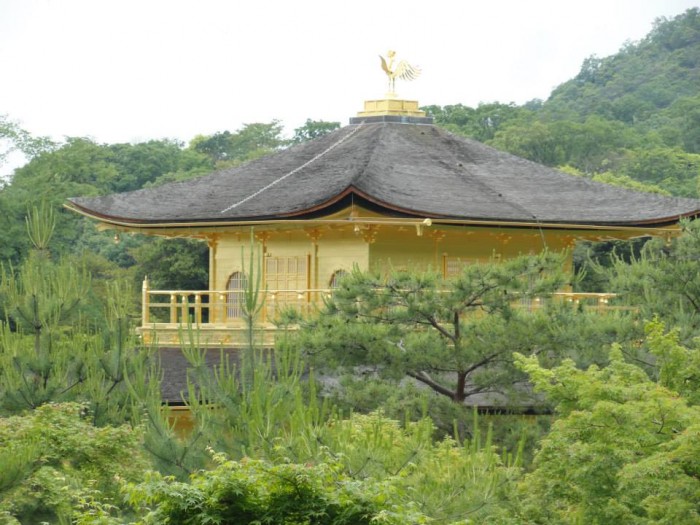If you know of a Columbia College student, faculty member, alumnus/alumna or program we should spotlight, or if you would like to submit a story, please contact:
Columbia College
Office of Communications
cc-comms@columbia.edu

“My experience in Japan caused me to consider questions I had never before realized existed and added another dimension to the academic inquiry I will engage in for the next three years.” — Trevor Menders CC’18
In May 2015, Trevor Menders CC’18 was one of 50 Columbia undergraduates to travel to Japan on the Columbia University-Japan Study Tour, a 10-day academic visit that included lectures, sightseeing and a host of cross-cultural experiences. Here, Trevor reflects on his experience abroad.
No amount of preparation could have readied me for the intensity of the ten days I spent across the Pacific on the Columbia University-Japan Study Tour. The program was created when Japanese Prime Minister Shinzō Abe visited Columbia in September 2014 and extended an invitation to 50 Columbia students to be the first cohort of American university students to take part in a ten-day academic visit to Japan, facilitated by the Japanese Consulate in New York and the Japan International Cooperation Center (JICE) in Japan. In May 2015, I, along with 49 of my Columbia peers, traveled by plane, bus and train to four different cities across Honshu, Japan’s main island, and feasted our eyes on national treasures, cutting-edge technologies and landmarks. As an East Asian studies major, I embarked on the trip exhilarated at the thought of personally engaging with a culture that I had previously only learned about through classwork and literature.
Our trip’s activities were indicative of the unique atmosphere of each city we visited. In Tokyo, the contemporary center of Japanese scholarship and innovation, we visited the National Museum and its enormous retrospective exhibit on two millennia of Japanese arts and culture. Artifacts I had just weeks ago studied through photographs for my East Asian civilization class were directly in front of me, behind mere centimeters of plexiglass. We explored the Fushimi Inari shrine, a Shinto site home to the famous outdoor hallways of bright red torii gates that climb endlessly up the surrounding mountainsides of Kyoto (the old imperial capital close to the Inland Sea, where religious sites crop up in every single block). We woke at 4 a.m. to see the sun rise and cast the day’s first light onto the acres of rice paddies outside Takashima City, a small city on Lake Biwa, whose main industries are mountain tourism and agriculture.
 Trevor Menders CC’18 and Janet Jisoo Park CC’16 at the Fushimi Inari Shrine in Kyoto, Japan. Photo: Courtesy Janet Jisoo Park
Trevor Menders CC’18 and Janet Jisoo Park CC’16 at the Fushimi Inari Shrine in Kyoto, Japan. Photo: Courtesy Janet Jisoo Park
At the end of our trip we returned to Tokyo to present reflection projects on our experiences to the students and staff of the Waseda University Global Leaders Program. By that time, I’d seen tableaus of breathtaking scenery, had flashes of insight while listening to lectures by eminent Japanese university professors and had generally come to a fuller comprehension of what Japan is, culturally, politically and historically.
Throughout the trip, however, what most inspired me were my interactions with the people I met in between all the curated moments — especially the Japanese college students at the two universities we visited, Doshisha University in Kyoto and Waseda University in Tokyo. As I had only begun to study Japanese in the spring 2015 semester, our conversations were conducted mostly in English (which the Japanese students spoke nearly perfectly). But because Japanese shares virtually nothing with English, unlike many Romance languages, if one of the Japanese students did not know the word they wanted in English, there was hurried and hushed consulting with other Japanese students to find the right term before the conversation could continue. No linguistic guessing games could get us very far; my meagre Japanese had little to offer in these moments. Even so, I managed to get a lot out of these intercultural dialogues.
The interaction that crystallized the most for me was one I had with a Doshisha sophomore who had just returned from studying abroad in North Carolina. I asked her questions about the Japanese university model: When did she have to declare her major? At the rapidly approaching close of her second year, though she had already decided. What had she decided on? English literature. That’s so cool! What was her favorite novel? She didn’t have one — she hadn’t read any yet.
 The view looking out from Takashima City in Shiga Prefecture, Japan. Photo: Trevor Menders CC’18
The view looking out from Takashima City in Shiga Prefecture, Japan. Photo: Trevor Menders CC’18
This English literature major hadn’t read any English literature yet — or perhaps just none she wanted to discuss. That floored me. I laughed, offered some book recommendations, and we continued our conversation. When we had to depart for our hotel, an hour away on the Inland Sea coast in Osaka, we exchanged email addresses, hugs and goodbyes. It wasn’t until the plane ride back to New York about a week later that her answer really hit me.
At first, the idea of someone majoring in English literature without having read any English literature seemed impossible to me. How could she have decided to spend her college career studying the products of a society so culturally different and physically removed from her own when she had so little previous interaction with it? Then, it struck me — how am I any different?
I am an East Asian studies major focusing on Japanese art history. I had never been to Japan before this trip, and I only recently started to study Japanese. I have always had an interest in Asia, but most of my reading before college had been on China, not Japan. How can I justify dedicating my college career to a culture so far removed from my own, one with which I have so little experience? In a world that continues to globalize at an unprecedented rate, learning about other cultures is a necessary and responsible thing to do. But to choose an area of intensive study, such as Japanese art history or English literature, in a culture so far removed from your own — where exactly does the exigency to engage so deeply come from? A choice of major goes beyond cultural awareness; it’s the potential dedication of a career and a life to a single subject.
 The main building at the Buddhist temple Kinkakuji, known in English as the Golden Temple, in Kyoto, Japan. Photo: Trevor Menders CC’18
I do not yet have the answers to any of these questions, and because of the Columbia University-Japan Study Tour, I think that’s okay. I imagine that if asked about her choice of major, the student I spoke to would probably answer by saying that — beyond a visceral attraction — she, too, does not know why she chose what she did. But if I had never spoken to her, I would never (or perhaps not until much later) have realized that these questions existed. They say ignorance is bliss, but understanding is much better — and this is why I applied to go to Japan in the first place. It is more important than ever to be not only culturally aware, but also to be culturally aware in a sensitive fashion, with a legitimate point of inquiry. I want to be part of a force that aids legitimate, informed cultural inquiry, and trips like the Columbia University-Japan Study Tour are the first step.
The main building at the Buddhist temple Kinkakuji, known in English as the Golden Temple, in Kyoto, Japan. Photo: Trevor Menders CC’18
I do not yet have the answers to any of these questions, and because of the Columbia University-Japan Study Tour, I think that’s okay. I imagine that if asked about her choice of major, the student I spoke to would probably answer by saying that — beyond a visceral attraction — she, too, does not know why she chose what she did. But if I had never spoken to her, I would never (or perhaps not until much later) have realized that these questions existed. They say ignorance is bliss, but understanding is much better — and this is why I applied to go to Japan in the first place. It is more important than ever to be not only culturally aware, but also to be culturally aware in a sensitive fashion, with a legitimate point of inquiry. I want to be part of a force that aids legitimate, informed cultural inquiry, and trips like the Columbia University-Japan Study Tour are the first step.
In the end, my experience in Japan caused me to consider questions I had never before realized existed and added another dimension to the academic inquiry I will engage in for the next three years at the College. What attracts me to the study of another culture? Maybe, at Columbia, in combining our vast array of Core texts with my East Asian studies pursuits, I’ll be able to get an inkling. And when I do, I hope I can go back to Japan and talk to someone about it.
Trevor Menders CC’18 is an East Asian languages and cultures major interested in the aesthetic exchange between Japan and the West. He is also passionate about arts administration and education policy.